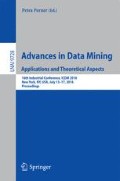Abstract
Objective: To develop an algorithm for aligning process traces that considers activity duration during alignment and helps derive data-driven insights from workflow data. Methods: We developed a duration-aware trace alignment algorithm as part of a Java application that provides visualization of the alignment. The relative weight of the activity type vs. activity duration during the alignment is an adjustable parameter. We evaluated proportional and logarithmic weights for activity duration. Results: We used duration-aware trace alignment on two real-world medical datasets. Compared with existing context-based alignment algorithm, our results show that duration-aware alignment algorithm achieves higher alignment accuracy and provides more intuitive insights for deviation detection and data visualization. Conclusion: Duration-aware trace alignment improves upon an existing trace alignment approach and offers better alignment accuracy and visualization.
Access this chapter
Tax calculation will be finalised at checkout
Purchases are for personal use only
References
Van Der Aalst, W.: Process Mining: Discovery Conformance and Enhancement of Business Processes. Springer, Heidelberg (2011)
Bose, R.J.C., van der Aalst, W.M.: Process diagnostics using trace alignment: opportunities, issues, and challenges. Inf. Syst. 37(2), 117–141 (2012)
Waterman, M.S.: Introduction to Computational Biology: Maps. Sequences and Genomes. CRC Press, Boca Raton (1995)
Needleman, S.B., Wunsch, C.D.: A general method applicable to the search for similarities in the amino acid sequence of two proteins. J. Mol. Biol. 48(3), 443–453 (1970)
Rakthanmanon, T., et al.: Searching and mining trillions of time series subsequences under dynamic time warping. In: Proceedings of the 18th ACM SIGKDD International Conference on Knowledge Discovery and Data Mining. ACM (2012)
Forestier, G., et al.: Classification of surgical processes using dynamic time warping. J. Biomed. Inf. 45(2), 255–264 (2012)
Müller, M.: Dynamic time warping. In: Information Retrieval for Music and Motion, pp. 69–84. Springer, Heidelberg (2007)
Holmes, W.: Speech Synthesis and Recognition. CRC Press, Boca Raton (2001)
Jain, A.K., Richard, C.D.: Algorithms for Clustering Data. Prentice-Hall Inc., Upper Saddle River (1988)
Ward Jr., J.H.: Hierarchical grouping to optimize an objective function. J. Am. Stat. Assoc. 58(301), 236–244 (1963)
Murtagh, F., Legendre, P.: Ward’s hierarchical clustering method: clustering criterion and agglomerative algorithm. arXiv preprint arXiv:1111.6285 (2011)
Levenshtein, V.I.: Binary codes capable of correcting deletions, insertions, and reversals. Soviet Phys. Dokl. 10(8), 707–710 (1966)
Edgar, Robert C. “MUSCLE: a multiple sequence alignment method with reduced time and space complexity.” BMC Bioinformatics 5.1 (2004): 113
Chang, J.-M., Di Tommaso, P., Notredame, C.: TCS: a new multiple sequences alignment reliability measure to estimate alignment accuracy and improve phylogenetic tree reconstruction. Mol. Biol. Evol. (2014). msu117
Landan, G., Graur, D.: Heads or tails: a simple reliability check for multiple sequence alignments. Mol. Biol. Evol. 24(6), 1380–1383 (2007)
Osnat, P., et al.: GUIDANCE: a web server for assessing alignment confidence scores. Nucleic Acids Res. 38(2), W23–W28 (2010)
Thompson, J.D., Plewniak, F., Poch, O.: A comprehensive comparison of multiple sequence alignment programs. Nucleic Acids Res. 27(13), 2682–2690 (1999)
Kelleher, D.C., et al.: Effect of a checklist on advanced trauma life support task performance during pediatric trauma resuscitation. Acad. Emerg. Med. 21(10), 1129–1134 (2014)
Bose, R.P.J.C., van der Aalst, W.M.P.: Context aware trace clustering: towards improving process mining results. In: SDM (2009)
Feng, D.-F., Doolittle, R.F.: Progressive sequence alignment as a prerequisite to correct phylogenetic trees. J. Mol. Evol. 25(4), 351–360 (1987)
Cornell, P., et al.: Transforming nursing workflow, part 1: the chaotic nature of nurse activities. J. Nurs. Adm. 40(9), 366–373 (2010)
Chakrabarti, S., et al.: Refining multiple sequence alignments with conserved core regions. Nucleic Acids Res. 34(9), 2598–2606 (2006)
Bashford, H., et al.: Workflow analysis in production homebuilding. In: 43rd Annual International Conference on Associated Schools of Construction (2007)
Rogge-Solti, A., Kasneci, G.: Temporal anomaly detection in business processes. In: Sadiq, S., Soffer, P., Völzer, H. (eds.) BPM 2014. LNCS, vol. 8659, pp. 234–249. Springer, Heidelberg (2014)
Clifford, D., et al.: Alignment using variable penalty dynamic time warping. Anal. Chem. 81(3), 1000–1007 (2009)
Acknowledgments
This paper is based on research supported by National Institutes of Health under grant number 1R01LM011834-01A1.
Author information
Authors and Affiliations
Corresponding author
Editor information
Editors and Affiliations
Rights and permissions
Copyright information
© 2016 Springer International Publishing Switzerland
About this paper
Cite this paper
Yang, S. et al. (2016). Duration-Aware Alignment of Process Traces. In: Perner, P. (eds) Advances in Data Mining. Applications and Theoretical Aspects. ICDM 2016. Lecture Notes in Computer Science(), vol 9728. Springer, Cham. https://doi.org/10.1007/978-3-319-41561-1_28
Download citation
DOI: https://doi.org/10.1007/978-3-319-41561-1_28
Published:
Publisher Name: Springer, Cham
Print ISBN: 978-3-319-41560-4
Online ISBN: 978-3-319-41561-1
eBook Packages: Computer ScienceComputer Science (R0)

